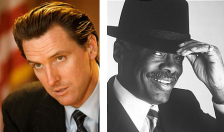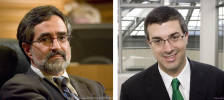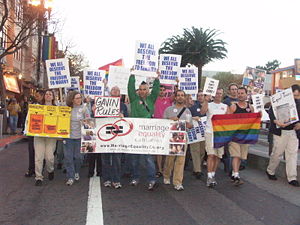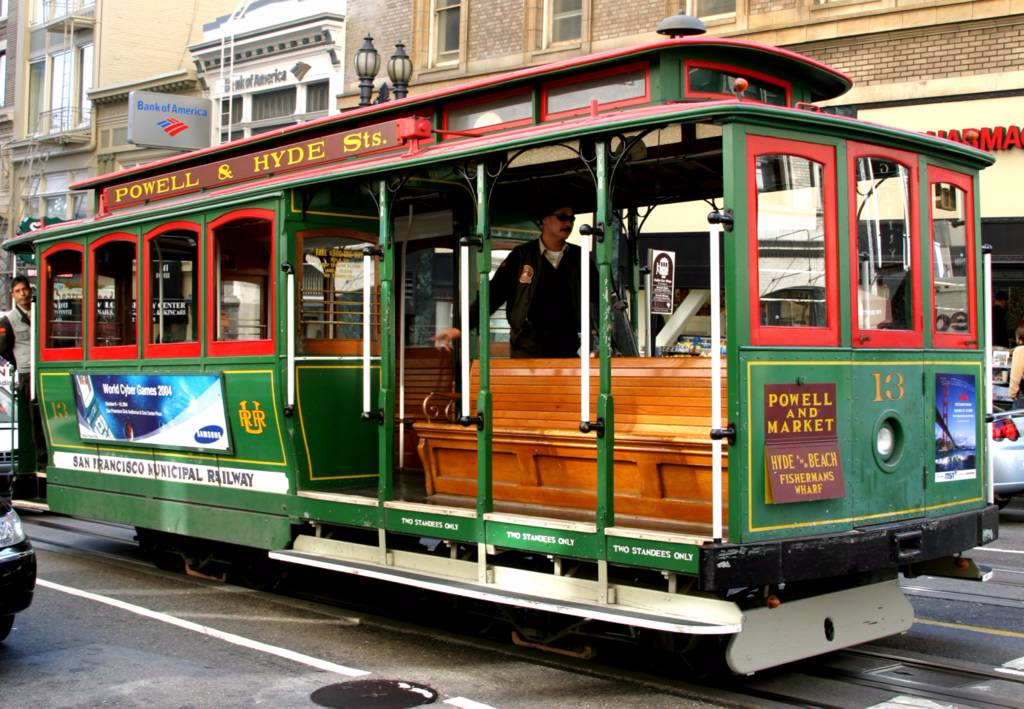San Francisco Bay Guardian, 2003-02-05, v37-n19 - 19golden
Tunnels of love: Numerous design changes in plans to build an 800-space underground garage in Golden Gate Park have angered activists who say the secret proceedings have undermined the public's intent and led to cost-cutting measures that could result in three historic pedestrian tunnels being demolished or filled in. This photo illustration shows what the popular tunnels could end up looking like if a private, not-for-profit authority gets its way.
photo illustration courtesy of chris duderstadt
Hellman's Hole
The wealthy interests behind Golden Gate Park's museums are destroying a popular civic treasure.
By Savannah Blackwell
The vision sold to voters nearly five years ago on campaign posters was an idyllic one: a pretty picture of the old Music Concourse in Golden Gate Park with no cars but replete with couples strolling, bicyclists serenely pedaling, in-line skaters passing by, and mothers pushing baby carriages.
It was this safe, pedestrian-friendly image that prompted key progressive activists to support June 1998's Proposition J, which passed by 57 percent, making way for an 800-space underground parking
garage. About half of the spaces would lie beneath Tea Garden Drive in front of the M.H. de Young Memorial Museum, and the other half would be under Academy Drive in front of the California Academy
of Sciences.
Warren Hellman, the Wells Fargo heir and politically active financier who pledged in 1998 to raise $40 million in private money for the garage's construction, even promised in a May 22, 1998, San Francisco Business Times commentary that "the facility will not disturb the bowl of the Concourse" and that the plan would be "the first step in a larger process of park revitalization and restoration."
He also promised that decisions on what the garage would look like and how it would affect the concourse would be made by a public authority (called the Golden Gate Concourse Authority) "governed by our elected officials."
But that's not what's happening.
Instead, a secretive, not-for-profit "charitable" organization, the Music Concourse Community Partnership (MCCP), created with Hellman's help, has, in an effort to save money, changed the design, straying far from promises to preserve the area's historic treasures — such as the 106-year-old pedestrian tunnels — and to create what was then heralded as a "pedestrian oasis."
The project, some say, is a sign of a creeping move to privatize Golden Gate Park.
An examination of public records shows:
• The new plans for the concourse won't reduce traffic. Motorists will still be able
to zip through the concourse to cut across the park — a proposal to reroute
through-traffic currently isn't funded. And tour buses will still be able to drop off
passengers on the concourse.
• The project will increase, not decrease, the number of cars in the concourse
area. The environmental impact report on the new garage acknowledges that
more than 200 additional cars an hour will be drawn to the area on Saturdays,
when the museums are busiest. Activists point out that not all of those cars will
use the underground structure; some will likely crowd into the park itself and
into surrounding neighborhoods.
• The entrance to the underground garage has been moved and will now be right
smack next to the concourse's western edge by the Spreckels Temple of Music,
also called the bandshell. Under Prop. J it was supposed to be outside the park
altogether.
• Three historic and popular tunnels will be demolished or filled in to build the
garage. Two are marked for replacement, though how that will be done and how
the work will be paid for have yet to be determined.
• The decisions to make these design changes, which directly conflict with what
the voters approved, were not hashed out in public. The decisions were all made
behind closed doors in concert with a private nonprofit, then ratified without any
real questioning by the Concourse Authority.
All of this has infuriated environmental and neighborhood advocates, who are bitterly fighting to block Hellman's plans and force a return to the earlier, less damaging proposals — or maybe even stop the garage altogether.
"This was sold to us as a way to make the park better and get the cars out of the park," Jennifer Clary of San Francisco Tomorrow, a group that opposed the measure, told us. "But where's the pedestrian oasis? They have a responsibility to fulfill their promises to the voters, but this is not going to result in a decrease of parking and traffic and an improved park experience. It's so offensive. We've been had."
Alarmed activists don't have a lot of time to react. Concourse Authority executive director and main staffer Michael Ellzey, who is paid with private funds raised by Hellman, told the Recreation and Park Commission Jan. 16 that he hopes the San Francisco Board of Supervisors will sign off in May and that "excavation" will start as soon as August.
MCCP's Dick Young acknowledged he has refused to let the public attend the group's meetings or review its financial documents, saying he wanted to protect the privacy of the donors.
"We are not subject to the Sunshine [Ordinance]," Young said. "There's nothing that goes on that couldn't stand the light of day. It's the project that's discussed [at MCCP] meetings and the fundraising."
Moreover, it's not clear the MCCP will limit its influence to just the concourse. Ellzey has stated to the Recreation and Park commission that in its role of limiting the impact of car traffic the Concourse Authority has jurisdiction over all roads and pathways in the park. And since the MCCP appears to be taking over at least part of the authority's decision-making role, that has activists worried its tentacles will reach all parts of the park.
De Young problems lead to Prop. J
De Young museum officials had long lamented that the closure of JFK Drive, which runs east-west through the park, on Sundays led to a reduced number of visitors on that day and hurt the institution's ability to attract major exhibits. In 1995 the museum's trustees considered rebuilding the museum, which was damaged in the 1989 Loma Prieta earthquake, elsewhere in the city. But public sentiment strongly favored keeping the de Young in the park.
In 1996, Mayor Brown suggested to the trustees that the museum stay in the park and that an underground garage be built to attract more visitors (see "Garage Sale," 9/11/96). But that year environmentalists defeated a $73 million bond proposal that included construction of the garage.
The next year trustees again floated plans to move the museum, but parent and children groups organized as the Coalition to Keep the de Young in the Park and threatened to put a measure on the ballot that would force de Young officials to keep the institution in the park. So the museum's backers sought the help of Brown in forging a compromise. In early 1998, Brown ally and former supervisor Michael Yaki held a series of negotiations with key activists, including coalition leaders Margaret Brodkin of Coleman Advocates for Children and Youth and Jill Wynns of the San Francisco Board of Education. They hatched a plan to put one measure on the ballot authorizing construction of the garage and a separate, $90 million bond measure to rebuild the de Young in the park.
Despite the promises of respected leaders such as Brodkin that the compromise would reduce traffic congestion in the park, opponents were concerned that the deal provided yet another example of the inherent danger facing leftist activists when they sit down to negotiate with representatives of wealthy interests: too often they get swindled and rolled.
Still the plan went forward with support from some of the city's progressives.
Dubbed by proponents the "Golden Gate Park Revitalization Act," the 1998 garage measure stipulated that its main purpose was "to create a pedestrian oasis in the Music Concourse ... and to take steps to reduce the impact of automobiles in the park, while still providing long-term assurance of safe, reliable and convenient access for visitors to the Park, including its cultural institutions." It did not mandate construction of a garage; rather, it "authorized" one.
Currently the plan calls for digging two huge, 30-foot-deep canyons under the north and south sides of the concourse that would be connected underground. The 200 parking spaces that are now located on the surface of the concourse would be removed. But in some ways the design does not jibe with the measure, activists say.
Prop. J's provision calling for the garage's entrances and exits to be located outside of the concourse area to reduce the impact of traffic is not being followed.
That's because a group called the North Park Neighbors Association objected to a plan to turn 10th Avenue into not just an entrance to the underground facility but also a new underground thoroughfare that would extend east of the concourse and the academy and eliminate the need for motorists to use the concourse surface to cross the park. The garage's architect, Gordon H. Chong and Partners, reported in February 2002 that the through street would have eliminated about 400 cars an hour going to the concourse's surface.
After the group met with Mayor Willie Brown last summer, the plan to turn 10th Avenue into an underground thoroughfare was dropped and a major entrance was added at the concourse's west side right near the bandshell — a move that will really congest and disrupt the area, according to members of the Alliance for Golden Gate Park, an activist group that opposes the garage.
"We're sympathetic [to the North Park Neighbors Association's concerns] of course, but it's troubling that this whole process is being governed by public relations and not legal issues," alliance member Stephen Willis said.
Outgrowth of privatization move in 1998
Warren Hellman and other wealthy interests have been vying to increase private fundraisers' influence on Golden Gate Park for years. In 1998, Hellman, among others, talked of creating a private body, possibly a nonprofit or foundation, to serve as the private component of a public-private partnership that would govern the park system — similar to the Central Park Conservancy in New York City (see "Private Parking," 5/6/98). Their feeling that former Recreation and Park director Joel Robinson wasn't friendly enough to the concerns of wealthy fundraisers led to a national search for a new director and Robinson's eventual resignation in April 2001. Exposure of the plans for a private body to influence the department resulted in proponents backpedaling — at least publicly.
The notion that wealthier interests should make key decisions affecting Golden Gate Park runs contrary to its history. John McLaren created the oasis with the philosophy of Central Park designer Frederick Law Olmstead in mind: that a large civic green space should serve the working class as a place to escape the congestion and stress of urban life.
Indeed, the concourse's own history follows that notion. It was built in 1894 for the general public to enjoy the Midwinters Fair.
But it's private interests tied to the city's wealthy that are determining the character of at least this part of the park — an "integral part of the fabric that makes Golden Gate Park a true pleasure ground," according to the Alliance for Golden Gate Park's November 2002 newsletter.
Private group determines design
Though the Concourse Authority, a public body whose seven members have each been appointed by Mayor Brown, is charged with making all of the decisions involving the garage, important matters are actually being determined behind the scenes by the MCCP.
The MCCP, whose main officer is Richard Young, a specialist in helping private interests invest in public assets, was created in August 2001 largely because donors to the garage's construction weren't convinced the Concourse Authority would manage the money the way they wanted, according to an authority member who asked not to be named. In addition, because it is a charitable organization, donations to the outfit would be tax deductible.
Since the MCCP is raising the funds for the garage's construction, it has made some key decisions affecting the facility's design. And the result hasn't impressed activists.
Folia Grace, a member of the North Park Neighbors Association, said at a Jan. 23 hearing on the environmental-impact report before the San Francisco Planning Commission that she was taken aback at the harsh aesthetics of the current design.
"The design ... is very industrial," Grace said. "It looks like we're getting a gaping hole with a utilitarian design."
That "industrial" design wasn't the original plan. Rather, the MCCP forced changes in order to keep the cost of the garage below $36 million, according to activists, authority members, and minutes of authority meetings.
At its Feb. 12, 2002, meeting, the Concourse Authority approved a design that was much more sensitive to environmental and aesthetic concerns.
That plan would have featured "light walls" — huge vent slots that allow natural light and fresh air from the surface to filter into the garage and serve as a natural ventilation system, according to Concourse Authority meeting minutes and schematics prepared by Chong and Partners, the garage's architect. In addition, one of the three tunnels now marked for demolition would have been preserved as a pedestrian gateway into the underground facility. Circular staircases would have connected the lower and upper levels on both the north and south sides of the garage. And Muni and tourist bus traffic would have been directed underground.
But at the authority's April 9 meeting, Ellzey broke it to board members that the funders considered the roughly $46 million project "over budget." Gone were the circular staircases.
"CEO Ellzey added that the funders have agreed that they are only offering a certain amount of money for a garage and the project was over budget," the meeting minutes say.
On hearing Chong representative Geoff Adams announce the firm had figured out a way to get construction costs down to $35 million in part by reducing the size of the garage's entrances for pedestrians (and jettisoning the circular staircase) but "without changing the quality ... of the garage," only one authority member — Sierra Club representative John Rizzo — raised objections.
Rizzo called the design a "radical departure" from the plan the authority members actually approved in February. Ellzey did acknowledge that the new design was "not the design that the Authority intends to pursue" but that he hoped a state initiative would pass that would provide additional funds.
By July, Ellzey was telling authority members the funders would only commit to a "baseline" garage and that the cost of any frills would have to be covered some other way. For example, private donors are no longer paying for the whole cost of replacing two of the pedestrian tunnels that will have to be demolished during construction. Instead, part of the money will come from Rec and Park. Those details are still being worked out, Ellzey told us.
In August, Ellzey informed the authority that the plan to route Muni buses underground, instead of on top of the concourse, had been ditched because it would cost $1 million a bus and Muni officials didn't like the idea, according to the Concourse Authority's August meeting minutes.
By September the natural ventilation system was gone. Without debating whether the project should be made cheaper or which features should be changed or dropped — issues they didn't discuss at any of the previous meetings either — the authority signed off on the latest design. Only Rizzo voted no and indicated he was tired of being left out of discussions over changing plans.
"The Sierra Club is still committed to seeing a car-free concourse," he told us.
Even with all of the changes, Ellzey told the authority members at their October meeting that the plans were still "in excess of the budget" and the design would change again. He didn't say what those changes would entail, and the authority didn't debate or discuss the matter.
So on Dec. 2 the authority signed off on the current plan. Ellzey presented the authority members with an even lower-cost design that called for the southwest tunnel to be permanently filled in with dirt, according to meeting minutes and the architects' schematics. In addition, the new plan raised the height of the garage so that less earth would have to be excavated, said Chris Duderstadt, a retired engineer and member of the Alliance for Golden Gate Park. Again, this would hold down costs, but it alters the surface elevation of the concourse -- even though Prop. J specifically stated that the surface elevation should not be changed. And the elimination of the natural light and ventilation system forced the addition of two huge ventilation structures outside of the concourse, to the north of the de Young and in the Rhododendron Dell to the northeast of the Academy of Sciences.
Rizzo told us the MCCP had forced the alterations to the plan.
"A lot of the design decisions were dictated by money, by the budget," Rizzo said.
That's a point on which Ellzey agreed. "Cost has driven some of our decisions," he acknowledged.
"It's is a fact of life of this project," he added. "It's like if my daughter wants a new car — a late-model BMW. But there is only so much money. I may not be able to get her a late 1990s model; it may be an early 1990s model. But it's still a BMW."
And recently, a plan Duderstadt offered that would spare the southwest tunnel was nixed by the MCCP, because it would cost more money, Rizzo told us. "That was an MCCP decision, because they're the ones holding the money and holding us to that budget," he said.
The MCCP's Dick Young also insisted that motorists who've parked their cars in the garage be able to walk from the facility directly onto the concourse. According to Rizzo, that means more impact on the concourse itself.
"The public has made it clear that this is what they want: a beautiful, peaceful, joyous, safe haven in the middle of Golden Gate Park," the alliance's November 2002 newsletter stated. "Now it's up to us to make this dream a reality." ❖
E-mail Savannah Blackwell at savannah@sfbg.com.
Sidebar: Environmental report is inadequate
Neighborhood and environmental activists have identified a host of problems with the Dec. 14, 2002, Draft Environmental Impact Report by EIP Associates.
• The EIR is based on a February 2002 design that no longer exists. Activists say it
doesn't make sense for the environmental review to have proceeded even
though the design has kept evolving.
"This is a fantasy, not a scientific document," Kathy Roberts, an Alliance for Golden Gate Park member, said at the Jan. 23 San Francisco Planning Commission meeting.
Activists say the report was rushed to make sure the garage was completed before the mid-2005 reopening of the Hertzog and de Meuron–designed M.H. de Young Memorial Museum.
Concourse Authority director Mike Ellzey said the revised report would reflect the changes made to the decision since February.
"We took a broad enough approach that it's unlikely that any of those changes will result in worsening of [environmental and other] impacts," Ellzey told us.
• The report doesn’t adequately address traffic effects to the park.
True, the Music Concourse Community Partnership has funded efforts to reduce the impact of cars — from traffic-calming studies for JFK Drive to the introduction of an intrapark shuttle — but the EIR says that once the rebuilt Academy of Sciences and de Young are open, the number of cars heading to the concourse area will increase by more than 200 an hour on Saturdays.
Many residents said the EIR makes a phony assumption: that motorists driving to the museums will opt to park in the garage. It’s likely, activists say, some park visitors will head out to the adjacent Inner Sunset and Richmond neighborhoods to find free parking.
• The draft EIR doesn't consider the garage as part of the overall context of
roughly $500 million worth of changes to the concourse (including both the de
Young's and academy's reconstruction projects).
Indeed, the alliance has complained to planners that the report doesn't meet state review standards because it fails to consider "the whole of the action." City Attorney Dennis Herrera, however, wrote a letter to the alliance in October saying that the report did not have to include consideration of the de Young and academy projects.
• The report underestimates the value and popularity of the 106-year-old historic
pedestrian tunnels.
The EIR acknowledges that removing the tunnels would "diminish the integrity of Golden Gate Park and the Music Concourse," but then goes on to declare the proposed changes "minor."
The plans call for two of the demolished tunnels on the north side to be replaced. But it isn't clear how they will ultimately look. Nor is it clear who will cover the cost of reconstruction.
The Landmarks Commission has written a letter to planners saying the current plans for the tunnels are not acceptable.
"The Landmarks Board cannot concur that the project meets the Secretary of the Interior's Standards for Rehabilitation," the commission's Jan. 21 letter says.
This is one area where Ellzey and the MCCP are probably going to have to fine tune the plan, and Ellzey acknowledges that. Both Recreation and Park director Elizabeth Goldstein and planning commissioner Michael Antonini have publicly stated concern for the preservation of the tunnels.
Antonini asked planners to study a 2001 proposal by alliance member Chris Duderstadt to build the garage directly north of the de Young, which would avoid the tunnels altogether.
"Those tunnels are an integral part of the walking experience in the park," Antonini told us. "Here they're going to pull up trees and tear down tunnels, it seems there must be some other way ... to make this as least disruptive as possible."
S.B.







